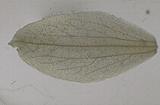|
[Front Page] [Features] [Departments] [SGAP Home Page] [Subscribe]

A Name Change for Most Eriostemons
Michael Bayly
Most of the familiar eriostemons (family Rutaceae) have recently undergone a formal name change. The new classification, which will be adopted in the Flora of Australia, sees Eriostemon comprising just two species (Eriostemon australasius and E.banksii), and the remaining 30 species placed in the related genus Philotheca. Some commonly cultivated species that have undergone this name change include E.myoporoides (Long-leaved Wax Flower), E.buxifolius (Box-leaved Waxflower) and E.verrucosus (Fairy or Bendigo Wax flower) from eastern Australia, and E.spicatus (Pepper and Salt) and E.nodiflorus from Western Australia.
This new classification is the work of Paul Wilson, from the Western Australian Herbarium, who was responsible for the last major work on the classification of Eriostemon (published in 1970), and who is preparing the account of this group for Flora of Australia. The aim of this classification is to have a system that best reflects our understanding of the evolutionary relationships of these plants.
The boundaries of genera in the Australian Rutaceae are little modified from those proposed by George Bentham in his Flora Australiensis, published in 1863. For some time, however, evidence has been mounting that, under this classification, species placed in Eriostemon are not part of a single evolutionary lineage, i.e., some species are probably more closely related to members of other genera than they are to each other. As early as 1954, for instance, it was suggested by Sidney Smith-White, a pioneering worker in the field of plant genetics, that Eriostemon australasius should be separated from other members of the genus.
Eriostemon australasius is a distinct, pink-flowered shrub (which is somewhat fickle to grow), and occurs naturally in heathland and open woodland on the east coast of Australia, from the southeast of Queensland to just south of Sydney. It, together with a closely related species from far north Queensland (E. banksii) is distinct from other eriostemons in having large flowers, flat and almost papery leaves that have obscure oil glands (rather than prominent warts), petals that have at least three main veins (rather than one), staminal filaments that are distinctly warty toward the apex, unusual stellate (star-like) hairs that resemble those found in some boronias, and a different chromosome number.

|

| 
|
Features of Eriostemon australasius and E.banksii.
Left: Petal cleaned with sodium hydroxide to show venation pattern. The petal has three main veins originating from the base. Other species traditionally placed in Eriostemon have petals with only one vein.
Centre: Close up of flower of Eriostemon australasius, showing warty oil glands toward the apex of the staminal filaments.
Right: Scanning electron micrograph of distinctive stellate hairs found on the leaves and petals of E.australasius and E.banksii
Select a thumbnail image or highlighted phrase for a larger resolution image (14k, 18k, 51k). Photos Michael Bayly
|
The remaining species traditionally placed in Eriostemon display a considerable range of morphological diversity but presumably (on the basis of the characters they share) are all related. Some members of this group, particularly many of the small-leaved species found in semi-arid areas (those that have been classified into section Nigrostipulae), also appear closely related to members of the small genus Philotheca. This genus has traditionally been distinguished from Eriostemon because its members have staminal filaments that are united into a tube for part of their length. It now seems, however, that placing these few species in a genus distinct from the small-leaved eriostemons is not well justified. The features that these two groups share include: leaves that are usually small, and often round in cross-section [and contain structural cells (called sclerieds) of a very distinctive form], hairy petals, strikingly similar seed morphology, staminal filaments that are erect when young but become recurved with age, and most notably, distinctive, stipule-like glands that occur on either side of the leaf bases.
Given these facts, Wilson's new classification recognises two distinct lineages as worthy of separation at genus level. One lineage is comprised only of Eriostemon australasius and E.banksii, and the other includes the remaining species traditionally placed in Eriostemon, as well as members of Philotheca. The assignment of names to these genera follows the rules of the International Code of Botanical Nomenclature. As such, the group including E.australasius (the type species for Eriostemon) must retain the name Eriostemon, and the other group must take the name Philotheca.

|

| 
|
Left: Philotheca cilata (Pilliga scrub, NSW). An example of a species traditionally placed in the small genus Philotheca on the basis of its basally-united staminal filaments.
Centre: Leaves of Philotheca sporadica (formerly Eriostemon sporadicus). Small leaves of this type are common in species traditionally placed in Eriostemon section Nigrostipulae as well as in Philotheca.
Right: Branchlet of Philotheca angustifolia (formerly Eriostemon angustifolius) showing small, black, stipule-like glands at either side of a leaf base. This feature is found in many species traditionally placed in Eriostemon section Nigrostipulae as well as in Philotheca
Select a thumbnail image or highlighted phrase for a larger resolution image (52k, 32k, 19k). Photos Michael Bayly
|
Most of the formal name changes were recently published in the journal Nuytsia (by Paul Wilson) and a smaller article, dealing only with name changes for the commonly cultivated Eriostemon myoporoides, was published in the journal Muelleria (by Michael Bayly). These changes are a positive step toward a more natural classification of the Australian Rutaceae but, as our knowledge of relationships continues to improve, and as is the way with plant taxonomy, I dare say they will not be the last!
Michael Bayly, School of Botany, University of Melbourne, Parkville, Vic. 3052, Australia
(Present Address: Museum of New Zealand Te Papa Tongarewa, P.O. Box 467, Wellington, New Zealand)

[Front Page] [Features] [Departments] [SGAP Home Page] [Subscribe]
Australian Plants online - March 1999
The Society for Growing Australian Plants
|